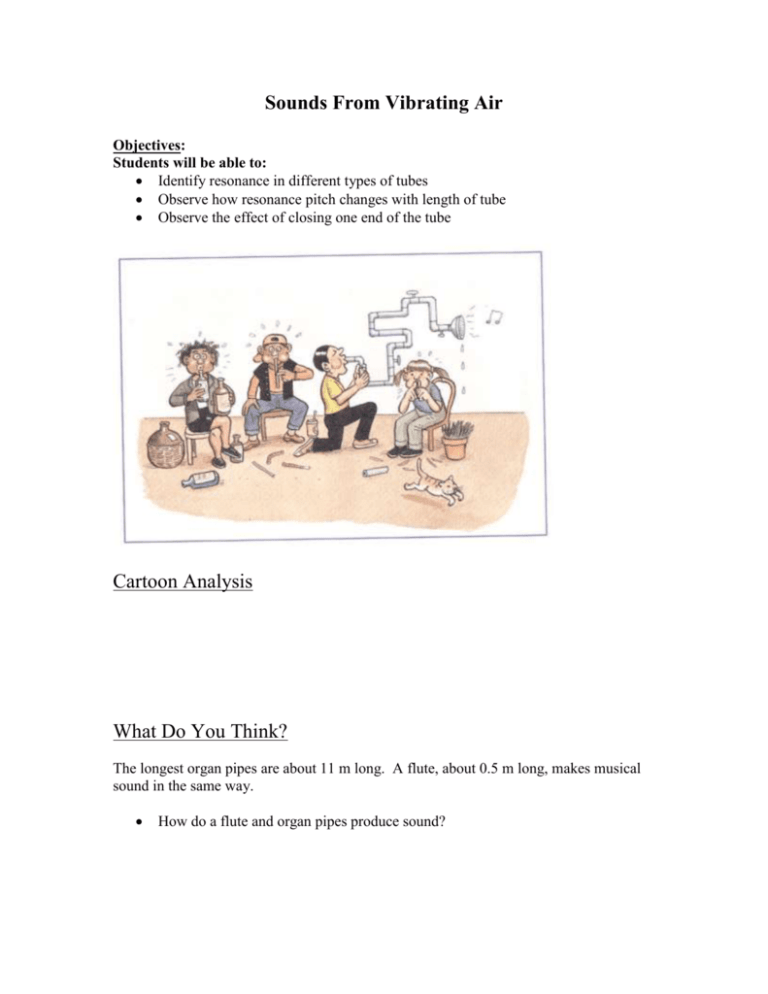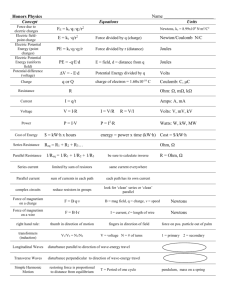Sounds From Vibrating Air
advertisement

Sounds From Vibrating Air Objectives: Students will be able to: Identify resonance in different types of tubes Observe how resonance pitch changes with length of tube Observe the effect of closing one end of the tube Cartoon Analysis What Do You Think? The longest organ pipes are about 11 m long. A flute, about 0.5 m long, makes musical sound in the same way. How do a flute and organ pipes produce sound? For You To Do 1. Carefully cut a drinking straw in half. Cut one of the halves into two quarters. Cut one of the quarters into two eighths. Give one part of the straw to each member of the group. 2. Gently blow into the top of the piece of straw. a) Describe what you hear. b) Listen as the members of your group blow into their straw pieces one at a time. Describe what you hear. 3. Measure the length of each straw and record the sound pitch for each length. Record you data in the table below. Length of Straw (cm) Sound Pitch (high, medium, low) 4. Write a general statement about how changing the length of the straw changes the pitch you hear. 5. Now cover the bottom of your straw piece and blow into it again. Uncover the bottom and blow again. a) Compare the sound the straw makes when the bottom is covered and then uncovered. Listen as the members of your group blow into their straw pieces, with the bottom covered and then uncovered. Write a general statement about how changing the length of the straw changes the pitch you hear when one end is covered. 6. Obtain a set of four test tubes. Leave one empty. Fill the next halfway with water. Fill the next three-quarters of the way. Fill the last one seven-eighths of the way. 7. Give each test tube to one member of your group. Blow across the top of your test tube. a) Describe what you hear b) Listen as the members of your group blow, one at a time, across their test tubes. Record what you hear. 8. Measure the length of air in the test tube and listen to the sound pitch each test tube makes. Record your data in the table below. Length of Air in Test Tube (cm) Sound Pitch (high, medium, low) 9. Write a general statement about how changing the length of air in a test tube affects the sound pitch you hear. 10. Compare the results of blowing across the straws with blowing across the test tubes. How are the results similar? For You To Read Vibrating Columns of Air The sound you heard when you blew into the straw and test tube was produced by a standing wave. If both ends of the straw are open, the air at both ends moves back and forth. The drawing shows the movement of the air as a standing wave. When you covered the other end of the straw, you prevented the air from moving at the covered end. The drawing shows the movement of the air as a standing wave. The velocity (speed) of a wave is equal to the frequency multiplied by the wavelength. Therefore, frequency = velocity __ wavelength Using mathematical symbols: f = _v_ As the wavelength increases, the frequency decreases. The wavelength in the open straw is half the wavelength in the straw closed at one end. This equation predicts that the standing wave in the open straw is twice the frequency of the standing wave in the straw closed at one end. Compressing Air To Make Sound Sound is a compression wave. The molecules of air bunch up or spread apart as the sound wave passes by. At the end where the tube is closed, the air cannot go back-and-forth, because its motion is blocked by the end of the tube. That’s why the wave’s amplitude goes to zero at the closed end. At the open end, the amplitude is as large as it can possibly be. This back-and-forth motion of air at the open end makes a sound wave that moves from the tube to your ear. Wave Diffraction As the sound wave leaves the test tube in this activity, it spreads out. In the same way, when you speak to a friend, the sound waves leave your mouth and spread out. You can speak to a group of friends because the sound leaves your mouth and moves out to the front and to the sides. This ability of the sound wave to spread out as it emerges from an opening is called diffraction. The smaller the opening, the more spreading of the sound. The spreading of the wave as it emerges from two holes can be shown with a diagram. The wave on the left is going through a small opening (in comparison to its wavelength) and diffracts a great deal. The wave on the right is going through a large opening (in comparison to its wavelength) and shows little diffraction. Cheerleaders use a megaphone to limit the diffraction. With a megaphone, the mouth opening becomes larger. The sound wave spreads out less and the cheering crowd in front of the cheerleader hears a louder sound. For You To Make A new musical instrument you can make uses a straw instead of a test tube. Take a straw and cut the ends to form a “v” as shown below. Flatten the “v” end of the straw and blow this “trumpet.” You can shorten the trumpet, decrease the wavelength of the standing wave and increase the frequency of the sound. Try making a sound. As you emit the sound, use scissors to cut ends off the straw. Listen to the different tones. Reflecting On The Activity In this activity you have observed the sounds produced by different kinds of pipes. If the pipe is cut to a shorter length, the pitch of the sound increases. Also, when the pipe is open at both ends, the pitch is much higher than if the pipe were open at only one end. You have seen how simple drawings of standing waves in these tubes help you find the wavelength of the sound. Reflection Questions 1. a) You can produce a sound by plucking a string or by blowing in a pipe. How are these two ways of producing sounds similar? b) How are these two ways different? 2. a) For each piece of straw your group used, make a full-sized drawing to show the standing wave inside. Use a ruler to draw it to size. Show both the straw closed at one end and open at both ends. Do this on a large, separate sheet of paper. b) Next to each drawing of the standing wave, make a drawing, at the same scale, of one full wavelength. Measure the wavelength for each straw. c) Write a general statement about how straw size affects the wave frequency. d) Write a general statement about how closing one end of the straw affects frequency. 3. What is the frequency of a sound wave that has a speed of 340 m/s and a wavelength of 6 m. 4. What is the wavelength of a wave that has a speed of 340 m/s and a frequency of 70 Hertz?








